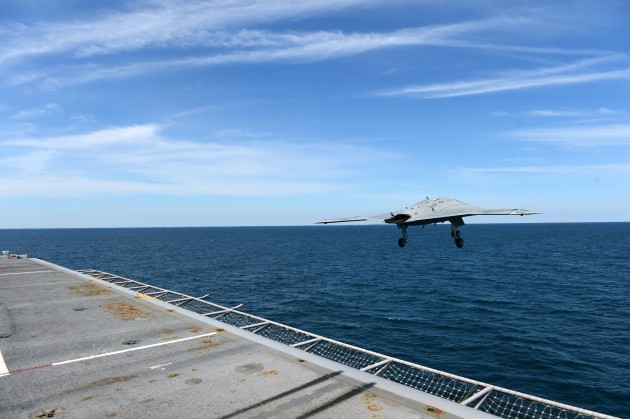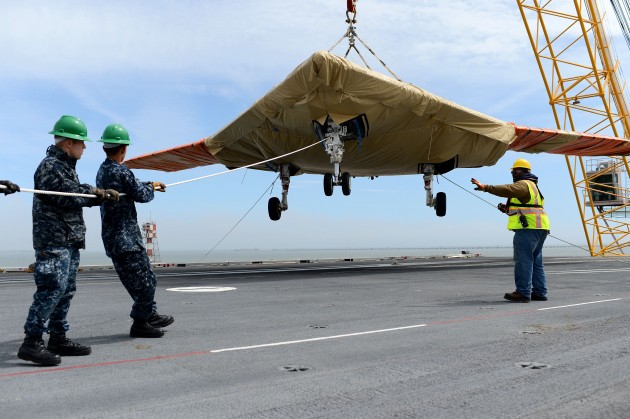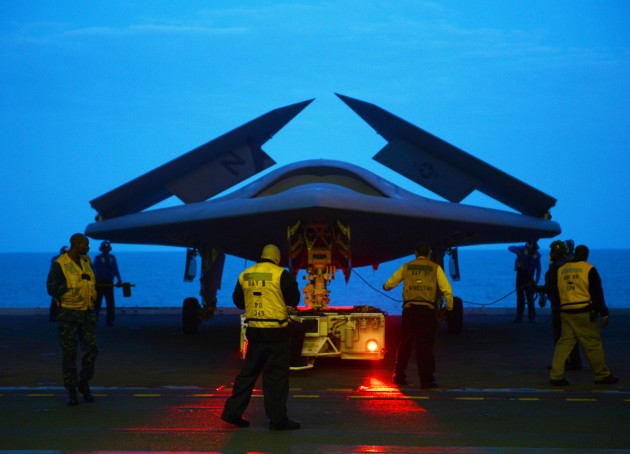X-47B: Navy Drone Launches Off Aircraft Carrier; A New Tailhook Era
Posted on

It’s hard enough for a human pilot to take off from the cramped and pitching deck of a US Navy aircraft carrier. Today, for the first time in history, a Remotely Piloted Aircraft did it. You can bet that military leaders in Beijing and Tehran sat up and took note as the batwinged X-47B drone took off from the nuclear-powered aircraft carrier USS George H.W. Bush.
[click here for video of the X-47B’s successful “tough and go” test a few days later]
The aircraft that took off today, the Northrop Grumman-built X-47B UCAS (Unmanned Combat Air System), is just the trailblazer for an actual combat-ready drone, the UCLASS (Unmanned Carrier-Launched Airborne Surveillance and Strike System), that the Navy plans to start developing in earnest this year. (The draft “request for proposals” is out and industry folks expect the final RFP to come out in the next few weeks). So, if the Navy gets its way — and sufficient funding, which is hardly a foregone conclusion — today’s modest 65-minute flight from the carrier at sea to the Navy’s celebrated “Pax River” test site ashore is just a taste of things to come.
[Click here to read about the next test for the X-47B and its Chinese “stealth drone” counterpart]
“People will say ‘wow,'” the Navy’s senior admiral, Chief of Naval Operations Jonathan Greenert, told me a few weeks ago when I buttonholed him after a congressional hearing to discuss the X-47B’s coming launch. “I think that will start a discussion.”
Why do Adm. Greenert and the rest of the Navy brass care so much? Two words, though they won’t often say them on the record: China and Iran. Both nations are building elaborate layered defenses of sophisticated radars, advanced anti-aircraft missiles, shore-based anti-ship cruise missiles, and ballistic missiles like a smart-bomb version of Saddam Hussein’s old SCUDs, all designed to keep US carriers and the aircraft they currently carry at bay. (Beijing also just rolled out a new drone of its own and announced it’s creating a new carrier-based air force, but China’s second-hand aircraft carrier is still a work in progress: Their really scary stuff is all shore-based).
Even the stealthy F-35 Joint Strike Fighters that the Navy, Marines, and Air Force are now beginning to buy will find it a challenge to penetrate these so-called “anti-access/area denial systems” (“A2/AD” in Pentagon shorthand). The problem: While the F-35s themselves are hard to detect on radar, the lumbering tanker planes that refuel them in mid-air are definitely not. Neither are the ground bases and aircraft carries from which the F-35s must launch.
Based on the different ranges of missiles available to Tehran and Beijing to keep us at arm’s length, Rep. Randy Forbes, the chairman of the House subcomittee on Seapower, told me recently in his Capitol Hill office, “we can only cover about a third of Iran and we can’t even get to China’s shore.”

To solve the penetration problem, the Air Force has a handful of B-2 stealth bombers — hard for radar to detect but relatively slow and vulnerable once the enemy does get a track — and is investing in a long-range, high-speed, radar-evading future bomber. The B-52s possess the range and payload, but they’re slow, highly visible on radar, and generally vulnerable to enemy aircraft and anti-aircraft missiles. And no matter what the exact type, heavy bombers can’t fit on a carrier flight deck.
Enter the drones (known to much of the military aviation community as Remotely Piloted Aircraft). An unmanned aircraft can be built much lighter and offer more room for fuel than one that has to accommodate a human. It can stay in the air longer than a human being can endure, and, if it does get shot down, there won’t be a military officer walking slowly up to anyone’s front porch with a grim expression and some tragic news. The future UCLASS drones will be primarily reconnaissance aircraft, scouting stealthily ahead of the main force to find targets for manned aircraft and cruise missiles, but they’ll be able to carry smart bombs as well. So — if it materializes on time, on schedule, and with the expected performance, always a trick in government programs — UCLASS will give the Navy a capability for long-range strike such as it’s never had.
So the X-47B launch is “a seminal event in the history of carrier aviation,” Seapower chairman Forbes said in an email to BreakingDefense today. “The UCAS-D/UCLASS programs will ensure the relevancy of the carrier air wing for the 21st century by providing an asset with the range, persistence and stealth needed to operate in increasingly contested environments…..This is a tremendous first step on the path toward forever altering the nature of naval aviation.”

A caveat: The UCLASS is not a silver bullet for future warfare. No single weapons system, manned or unmanned, ever is. From the Navy and Air Force standpoint, they’re just one aspect of a complex concept known as “AirSea Battle.”
“UAVs [unmanned air vehicles] are a part of the future of military aviation, not the future of military aviation,” said Ed Timperlake, a contributor to our site and a former Marine Corps fighter pilot who’s worked in the Pentagon and Congress.
Ultimately, in fact, no amount of airpower, automation, or other advanced technology is going to ensure victory, as the US found out painfully in Iraq. “There’s been lots written about avoiding using humans in conflict,” harrumped the head of the Association of the US Army, retired Gen. Gordon Sullivan, speaking at an AUSA event this afternoon. “You can’t do it.” And Sullivan is no Luddite: As Chief of Staff of the US Army, he pushed what was called the “Digital Division,” the forerunner of the battlefield wi-fi networks commanders use to coordinate ground operations today in Afghanistan.
Now the Army has gotten the Marine Corps and Special Operations Command to start an “Office of Strategic Landpower” to work on the “human domain” of warfare as an intellectual counterweight to the Air Force and Navy focus on high-tech systems for AirSea Battle. “This isn’t an anti-technology pitch at all,” said Gen. Robert Cone, head of the Army’s powerful Training and Doctrine Command (TRADOC), speaking after Gen. Sullivan. From the ground-combat point of view, he said when I asked him about the Navy UCAS, “one of the best applications we’ve seen in unmanned aerial vehicles is the smallest ones,” where young Army captains send modest drones to check out what Taliban might be lurking over the next hill.
“I think the key is to put the human first,” Cone told me afterward, “and then see how the technology enables the human.”
No amount of technology can make war bloodless, painless, or clean. And no one wants a war, either in the Middle East or in the Pacific. But today’s pioneering flight by the X-47B, and the more powerful combat drones that will follow, should hopefully remind America’s would-be adversaries around the world why they really don’t want to start one.
Updated 1:05 pm 15 May to add mention of Chinese UAV; updated 5:35 pm 14 May to correct description of casualty notification process; updated 5:20 pm with Army commentary; updated 5:00 pm with news about China’s new carrier-based air units.
Subscribe to our newsletter
Promotions, new products and sales. Directly to your inbox.
